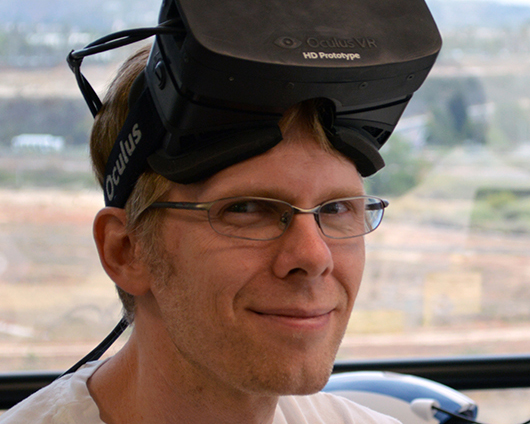John Carmack Joins Oculus Rift as CTO
by Jarred Walton on August 7, 2013 12:55 PM EST- Posted in
- Oculus Rift
- id Software
- John Carmack
- VR

The Oculus Rift Kickstarter page (and various other places) announced today that John Carmack is joining them as their new Chief Technology Officer. John is one of the biggest names in the industry of 3D gaming, having been on the forefront of technology with Wolfenstein 3D, Doom, Quake, and Rage. The fact that he’s interested in Oculus Rift shouldn’t come as too much of a surprise, and in fact everyone I know that has had a chance to see the technology in action has been impressed. I wasn’t able to get there at CES 2013, but I know Brian stopped by—he mentioned that the transition from the Virtual Reality environment back to the real world was disorienting, in a good way (i.e. it was much better VR than we’ve seen in the past).
Of course, this isn’t the first time John has had anything to do with Oculus Rift—he was the first developer to get the Oculus running with a 3D game (Doom 3). In a statement to the community he writes, “I have fond memories of the development work that led to a lot of great things in modern gaming – the intensity of the first person experience, LAN and internet play, game mods, and so on. Duct taping a strap and hot gluing sensors onto Palmer’s early prototype Rift and writing the code to drive it ranks right up there. Now is a special time. I believe that VR will have a huge impact in the coming years, but everyone working today is a pioneer. The paradigms that everyone will take for granted in the future are being figured out today; probably by people reading this message. It’s certainly not there yet. There is a lot more work to do, and there are problems we don’t even know about that will need to be solved, but I am eager to work on them. It’s going to be awesome!”
Just to be clear, John isn’t leaving id Software for this new position; he will continue his work there, as well as with other companies/projects. It’s also interesting to look at the last id Software release, Rage, and think about what John might have to say regarding gaming performance of the Oculus Rift. Rage basically made itself useless as a benchmark by targeting a maximum frame rate of 60FPS, and it would dynamically adjust quality to hit 60FPS as best as it could, generally succeeding even on relatively low-end hardware. For Virtual Reality, I can see having a constant 60FPS stream of content being far more important than getting additional graphics quality, so hopefully John can help other developers realize that goal.
As for the Oculus Rift, with many (over 17000!) development kits having now shipped to the community, as well as showcasing the 1080p HD version at E3 2013, we’re getting ever closer to the final hardware. The 0.2.3 SDK is also available, and besides the $2.5 million from the initial Kickstarter campaign, Oculus Rift has brought in a significant amount of additional funding over the past year. There’s still no official release date, but given the progress from the last year I’d expect to see the first consumer release within the next year, and very like before then. I’m sure they’d love to get on shelves before Christmas this year, but whether or not they can manage that remains to be seen.
Source: Oculus Rift Blog










25 Comments
View All Comments
Death666Angel - Friday, August 9, 2013 - link
What are you talking about? Every post I've read on the KS page has stated that they see themselves very far away from release. You are pulling stuff out of your other end, aren't you?Randomblame - Wednesday, August 7, 2013 - link
The most important missing feature is (and you all know it) the groin attachment. :pSeannyB - Thursday, August 8, 2013 - link
For how Carmack has been focused on graphical immersion all these years, it makes sense that he joined Oculus. You don't need a John Carmack to make generic shooter games anymore.I think one of the major problems with the dev. Rift is how it makes you demand so much more from the VR experience. You want to stand up, walk around and feel things in the virtual world when you put it on. The low-hanging fruit of adding 6-DoF head tracking, better optics, and a higher-res panel isn't going to alleviate that frustration. But if you start getting bulky VR rigs involved, then it very quickly relegates itself to a niche.
Impulses - Friday, August 9, 2013 - link
Proper head tracking would actually go a long way towards delivering accurate surround audio from a pair of stereo headphones... That's the way the Smyth Realizer does it, it's a niche product because of cost and the fact that no one wants to wear an extra attachment on top of headphones, but if you're already donning headgear... This could be the biggest leap in gaming audio since the first surround cards came out 15 years ago (RIP Aureal).piiman - Saturday, August 10, 2013 - link
And how many have died due to crappy buggy products? Add to that that there doesn't seem to be anything like OR (in the same price range) coming anytime soon, or at all, and I see no reason for them to rush to market. Personally I think you'd make a really bad CEO.